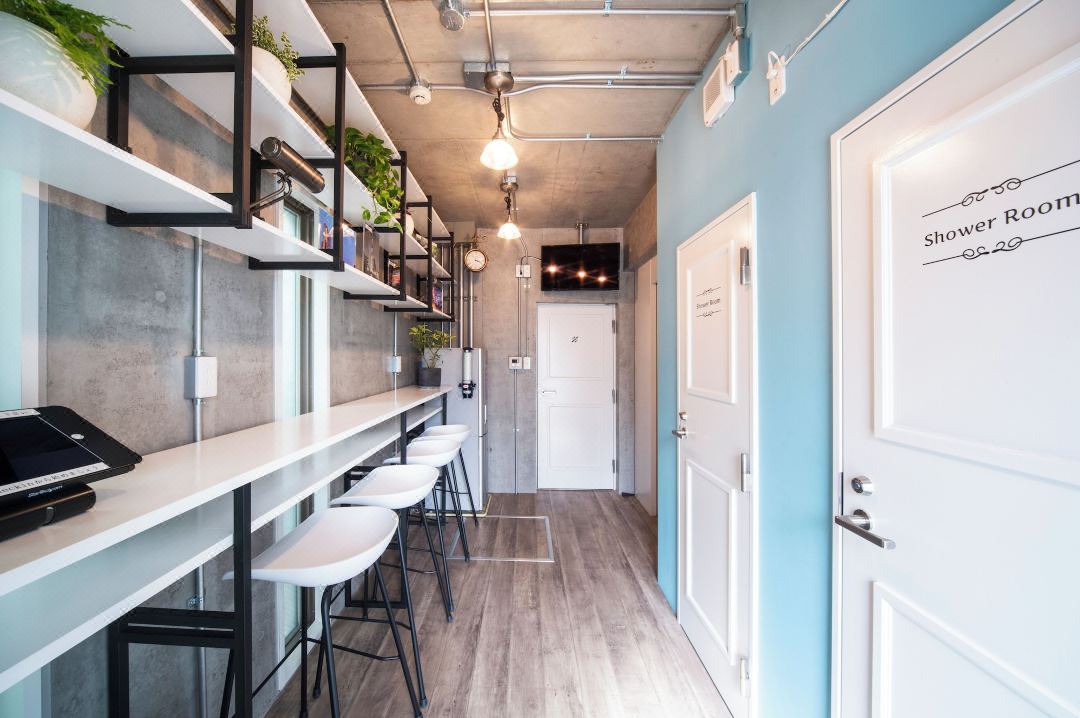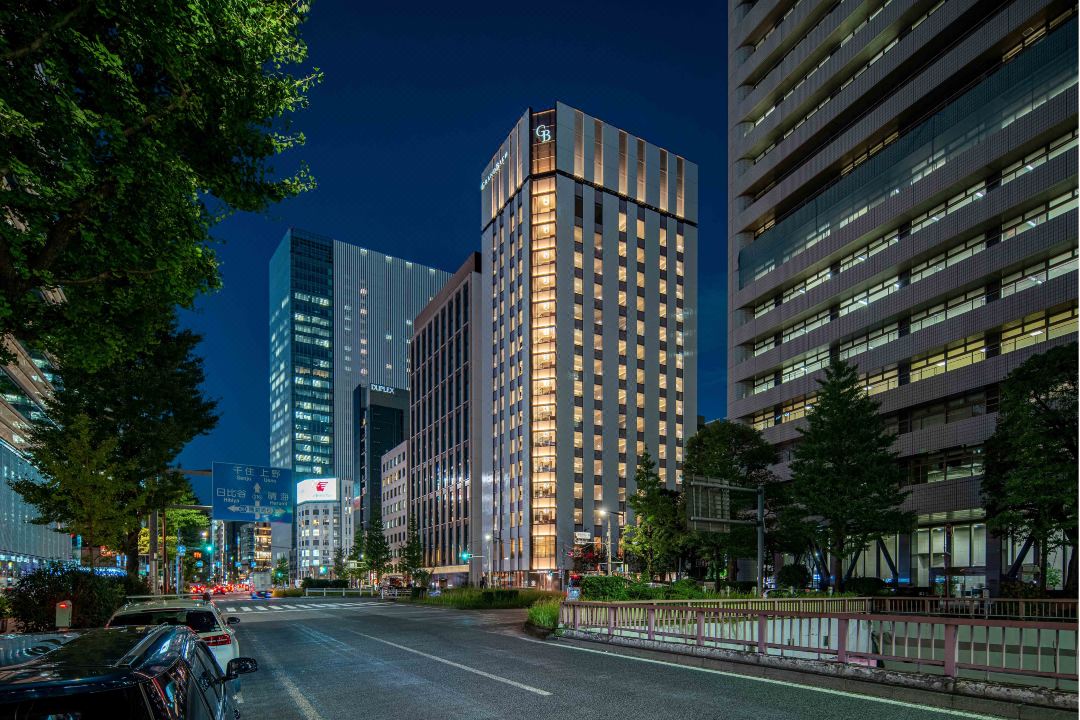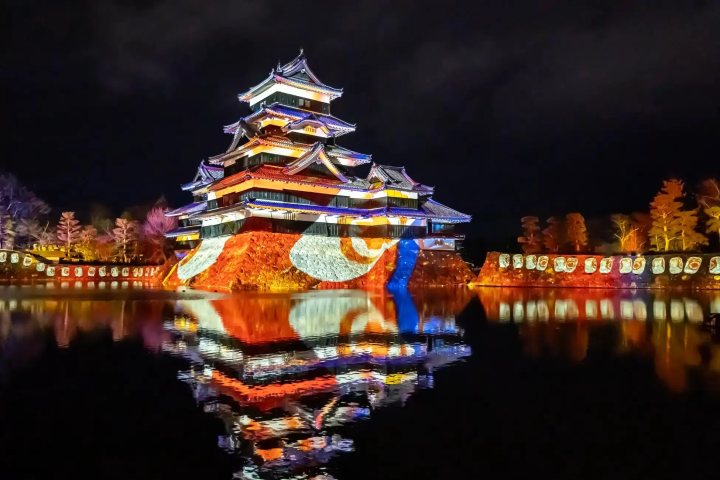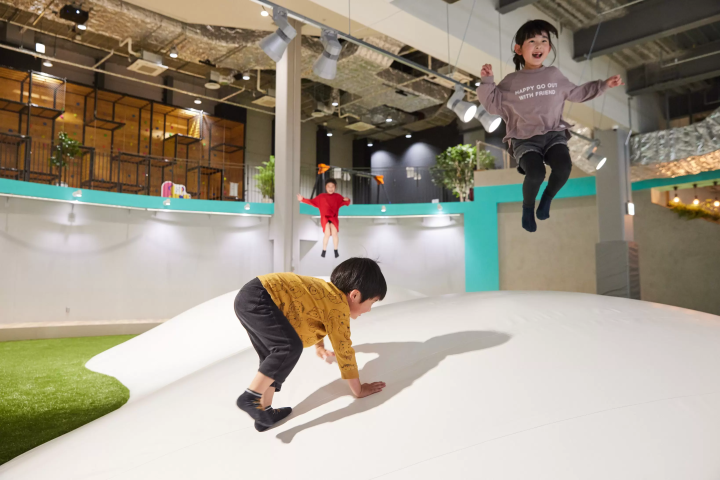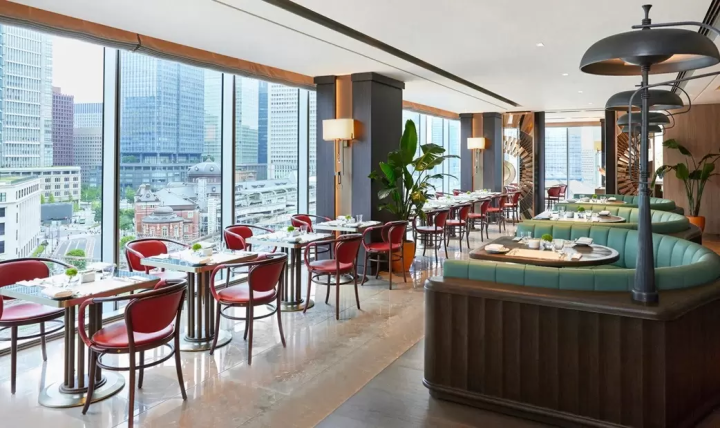A Stay for the Cultural Aficionado: Ito Ryokan

Ito Ryokan is a splendid Japanese inn located in Tokyo's Ningyocho district. This ryokan is famous for offering Japanese cultural activities such as shamisen playing and Japanese calligraphy.
Welcome, and to those of you continuing to follow my Tokyo Ryokan Stories, welcome back. My name is Roza Akino, and I live and work in Japan. I love staying at traditional inns, ryokan, and am really excited to have this opportunity to explore lesser-known lodgings throughout Tokyo. Let’s dive in!
Today’s lodging is Ito Ryokan, a Japanese inn located in the Ningyocho area, a quaint and quiet shitamachi neighborhood with remnants of traditional architecture and shops. Since today’s interview will involve some cultural experiences, I’ve decided to wear one of my casual kimono. As I approach the ryokan, I see some flowers for sale on the corner of the street, just outside of the side entrance.
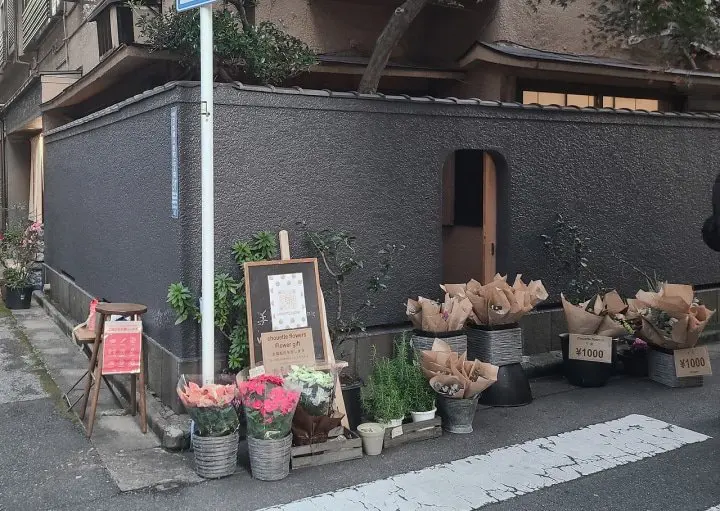
Flowers for sale right outside the ryokan
The area is all for preservation of small shops, even going so far as to prohibit any large supermarkets.
I enter through the wooden sliding-door entrance, and the manager, Chikako Maeyama, greets me at the door with her warm smile. She and the staff lead me to one of the guest rooms, where we will have our interview. As she introduces herself, she says, “Please call me Chikako, we go by our first names here.”
The room is beautiful – with a decadent uchikake kimono (a wedding kimono) and an antique obi sash on display.
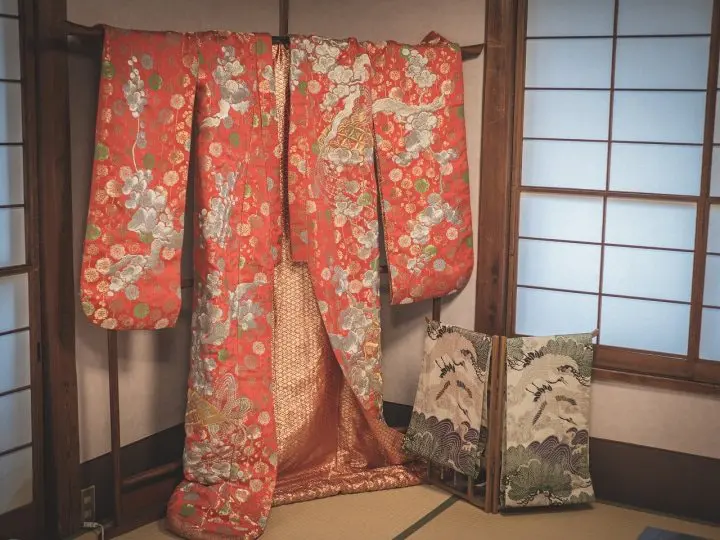
Uchikake and obi on display
The architecture, the ceiling, every aspect of the room exudes attention to detail. The futon looks fluffy and inviting, especially on this cold day.

Look at how comfortable that futon looks—don’t you just want to curl up and take a nap?
Chikako-san offers me some of the amazake (a traditional sweet fermented rice drink) that her mother made. This area is apparently so famous for its amazake that a street nearby is called Amazake Yokochō. There are still shops that sell various types of amazake, but Chikako-san prefers the slightly sweeter Kagoshima version that her mother makes.
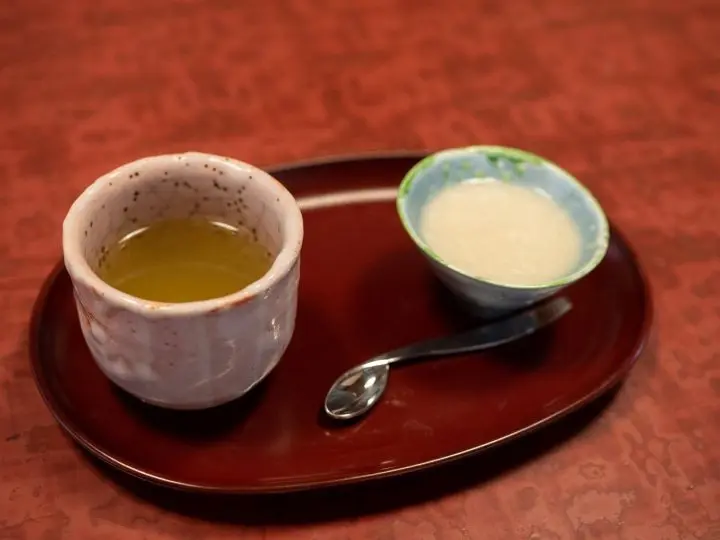
Tea with amazake made by Chikako-san’s mother
This ryokan was originally purchased by the current owner’s mother, Suzu, in 1953, from the previous owner, Ito-san.
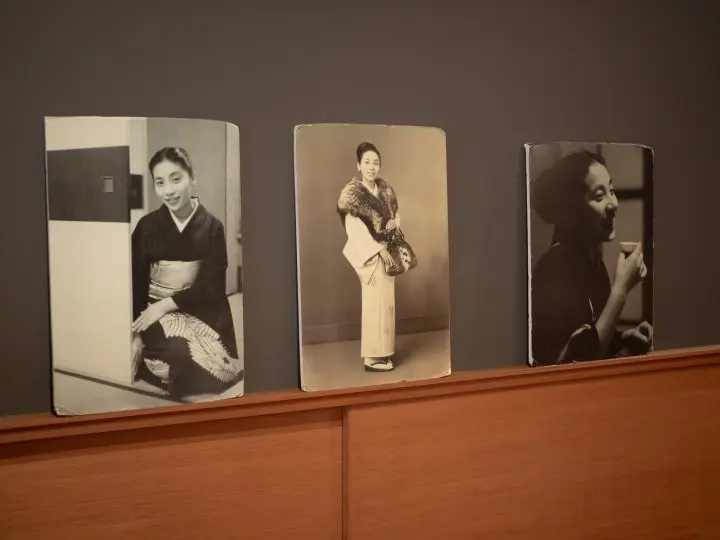
Old photos of Suzu displayed in the entrance of the ryokan
Eventually, the ryokan was passed down to Suzu’s son and current owner, Toshihide Sugiyama-san, with Chikako-san acting as manager. Chikako-san proceeds to show me some old photos from the time when Suzu was the proprietress, almost 80 years ago.
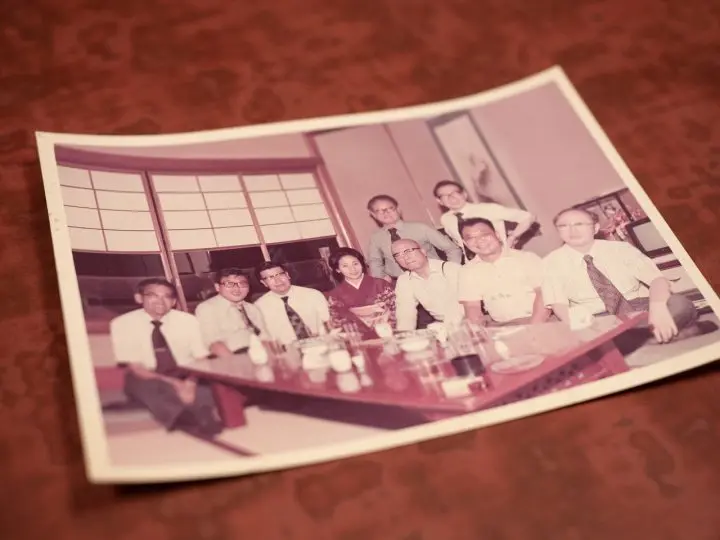
One of the old photos from Suzu’s time
Most of the cups and dishes, as well as the decorations were all chosen by Suzu, and when this ryokan underwent a renovation three years ago, Chikako-san decided to once again take out and use all of the original items of the ryokan that had been put in storage. I think to myself, this is the perfect example of the appreciation for old things that is prevalent in Japanese culture.
In Suzu’s time, the area was full of okiya, traditional geisha houses, and theaters—geisha were often seen walking around the area, and actors would often come and stay at the ryokan. The atmosphere of Ito Ryokan is very welcoming, and it seems like the kind of place that you could just pop in unannounced, just to say hi.
An interesting aspect of this ryokan is that although it’s a traditional inn, it has a very at-home feel. You are free to use whatever is in the room, and there is a variety of teas and drinks available for the guest (however depending on the day, there may be more or less types to choose from).
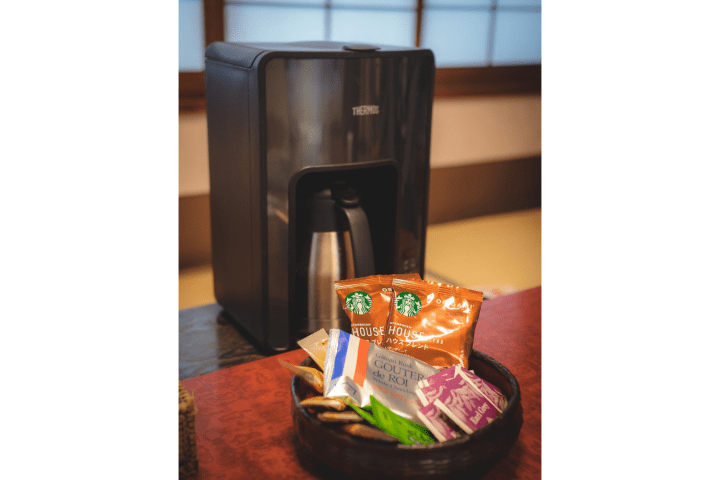
Tea, snacks, and a coffee maker
Each room is also equipped with a coffee maker. All 6 rooms in the ryokan have different ceilings, utilizing traditional materials such as woven bamboo, cedar, and other natural woods.
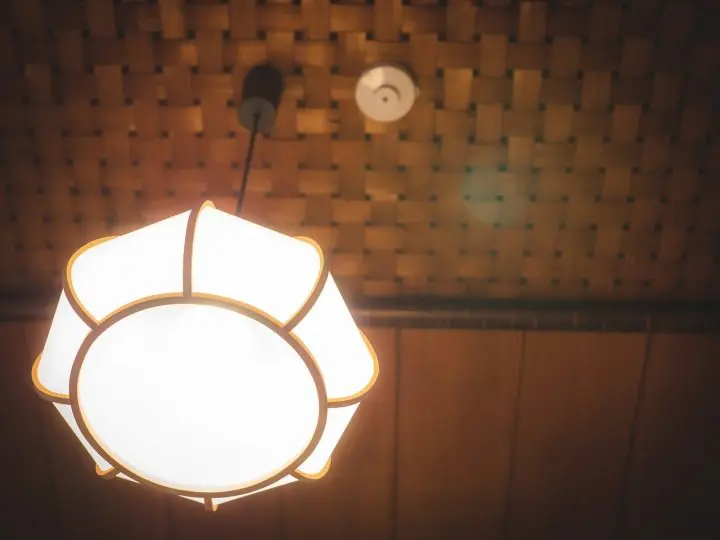
A woven bamboo ceiling
This particular room uses seven large boards for the ceiling, each one made from a very large cherry blossom tree—a luxury that would be difficult to afford these days. The way this ryokan was built is also unique. It was assembled according to traditional Japanese carpentry methods, without the use of any glue or nails.
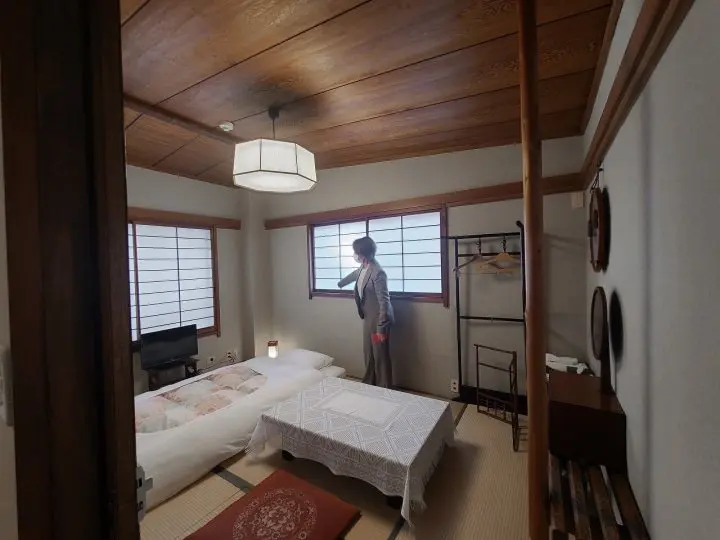
Each room is completely traditional
It also utilizes traditional dirt walls, tsuchikabe, which are nowadays usually only seen in traditional tea rooms or high-class traditional restaurants due to their cost and painstaking manner in which they are made. The traditional methods used in this building make it a rare architectural treasure, and the decision to preserve it in its original state during the renovation was not one that was taken lightly.

Each room has a different ceiling design
After the renovation three years ago, the goal of this building was to turn it into a place where people could gather, a place that could promote the beauty of traditional Japanese culture to visitors from abroad. This is apparent in the variety of cultural experiences that are offered here as well.
Chikako-san informs me that she actually has a full day scheduled for me: a trial shamisen lesson, a food tasting, and finally, a shodō calligraphy lesson—all of which I am more than happy to participate in.
First is the shamisen. Chikako-san takes me to the room on the first floor that is used for various cultural experiences. Tokiwazu Saiō-sensei is already waiting for me in her decadent kimono and perfectly coiffed hair. Her perky personality is a pleasure to be around. While it is often difficult to find a place where one can casually experience traditional arts such as shamisen, I can already feel myself relaxing as I speak with Saiō-sensei.
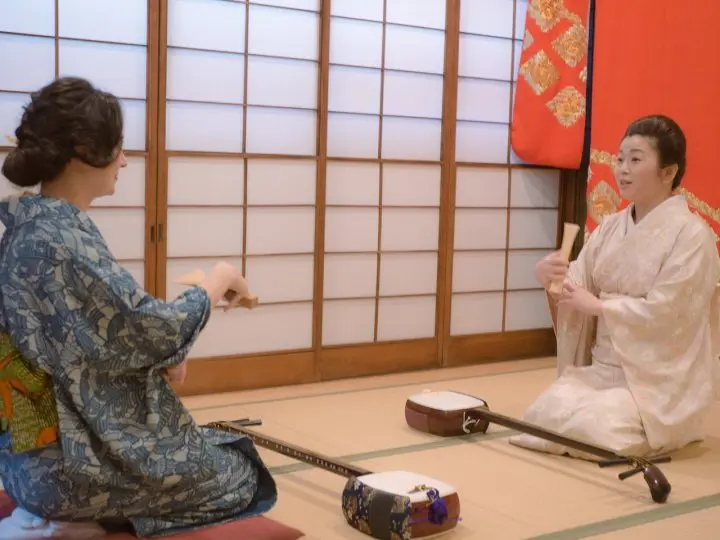
Saiō-sensei and I in the middle of our lesson
Her teaching style is fun and easy-to-understand, and by the end of our lesson I find myself able to play “Sakura Sakura,” a famous Japanese folk song. Guests who want to experience a shamisen lesson can make a reservation with the ryokan. Although shamisen reservations made through the ryokan’s website are for a different teacher, Saiō-sensei is also available by request for an extra fee. Both teachers can conduct the lesson in English.
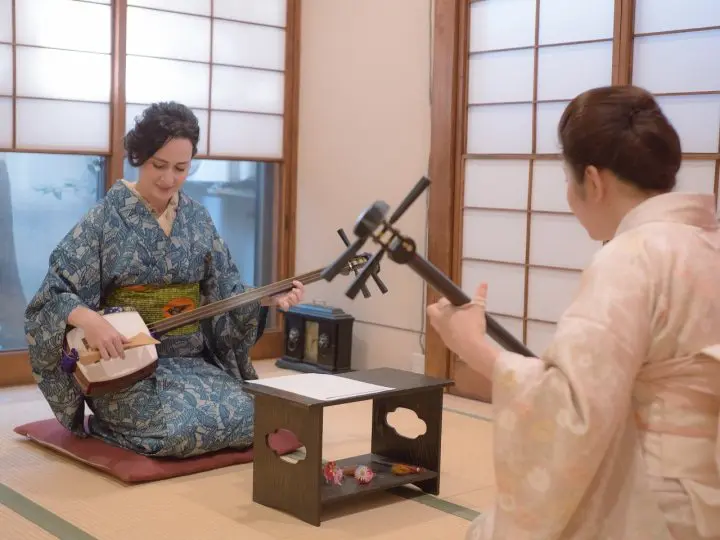
Sakura, sakura
After my shamisen lesson finishes, I realize that I’m actually quite hungry.
While a traditional Japanese breakfast is available for guests who request it, the ryokan doesn’t serve dinner. However, the first floor of the ryokan is connected to a Japanese restaurant, Nihonbashi SANO, which is sure to satisfy your cravings for Japanese food. I take a seat, and the chef brings out three dishes – pickled mackerel sushi, a traditional egg dish, dashimaki tamago, and one of my favorite dishes of all time: ankimo (monkfish liver). Ankimo is a popular dish that goes well with alcohol, specifically Japanese sake. I am so moved by the flavor of the ankimo that I can’t help but say so over and over as I indulge.
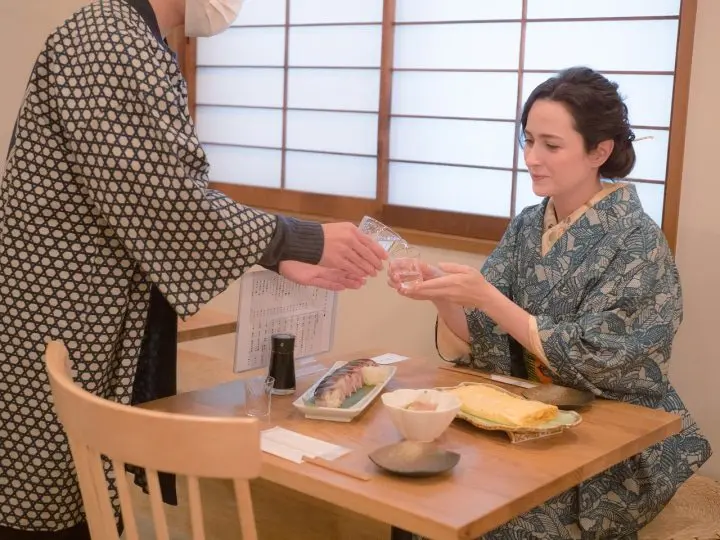
The atmosphere here is very relaxing and the food is excellent, with a good selection of sake. Of course, you can come and eat here even if you are not staying at the ryokan.
With just the right amount of sake in my system, Chikako-san takes me back to the lesson room, just in time for the calligraphy lesson—after all, it’s best to be in a relaxed state to let the brush strokes flow, is it not?
This time, it is calligrapher Honda-sensei of the Hanabusa Shodo calligraphy class.
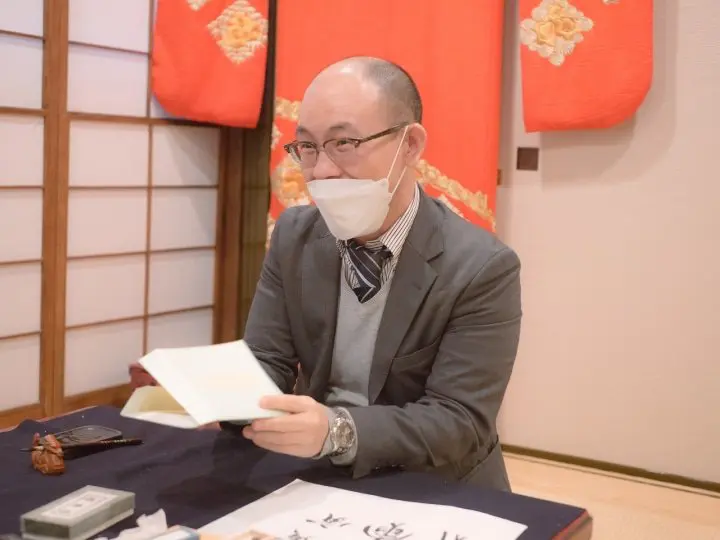
Honda-sensei
As Honda-sensei brings out his various calligraphy utensils, I am enraptured by each piece and its unique characteristics. He explains the various suzuri, ink stones, and ink sticks, and allows me to pick the two that speak most to me.
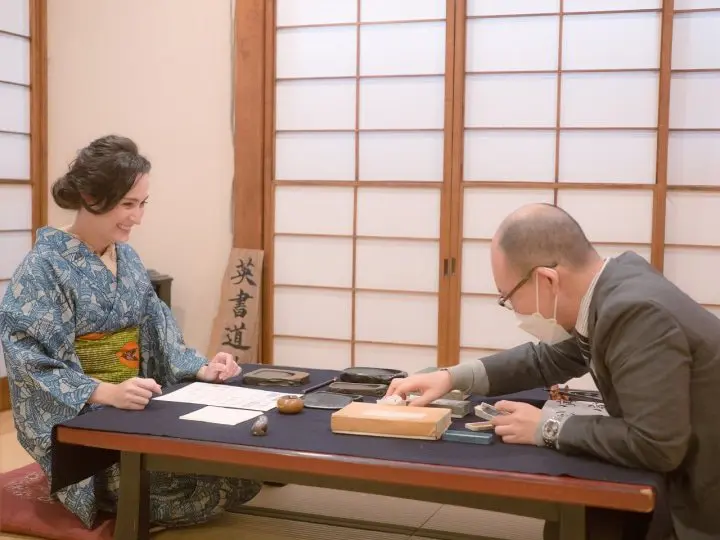
While nowadays it’s common to use pre-made liquid ink, grinding the sumi against the inkstone to make the ink consistency to your own preference is also an important part of doing calligraphy. The sound and tactile vibration of the sumi grinding against the inkstone is soothing, almost meditative. As the sumi turns to liquid, I notice a particular, soothing fragrance that it emits.
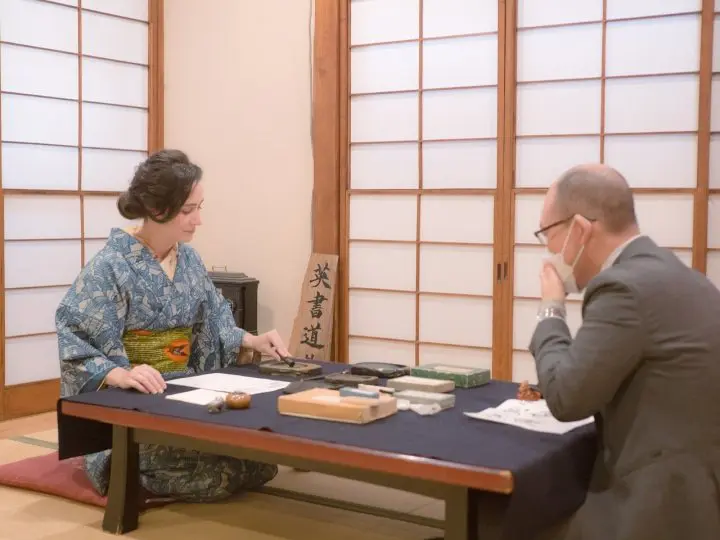
Grinding the inkstone
Honda-sensei guides me through the strokes of the kanji for “tiger”, the Chinese zodiac animal for 2022. With his help, and after several tries on practice paper, I am able to create a decent-looking piece of calligraphy.
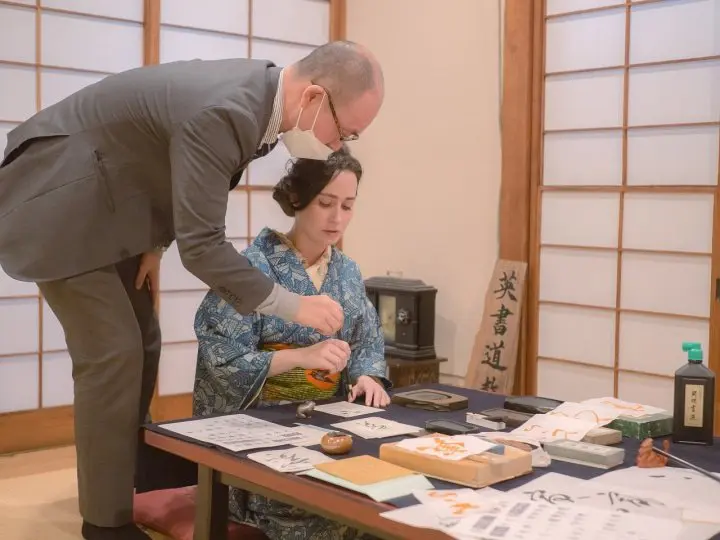
Honda-sensei giving me pointers on how to improve my strokes
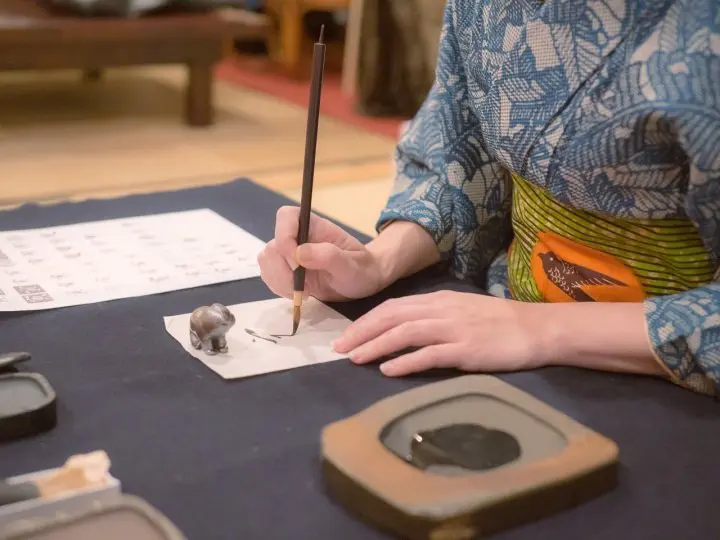
As a final touch, Honda-sensei paints a stamp-like version of my name in red ink, which would usually be carved out of stone and stamped on rather than written free-hand, to act as my signature on the piece.
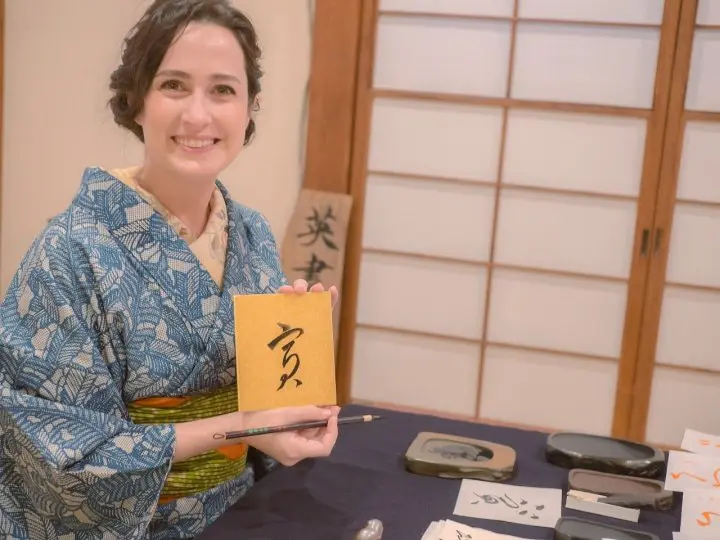
My finished character for “tiger”
He teaches here every Wednesday and Sunday, and as with the shamisen lesson, his lessons are available as an option for guests that stay here.
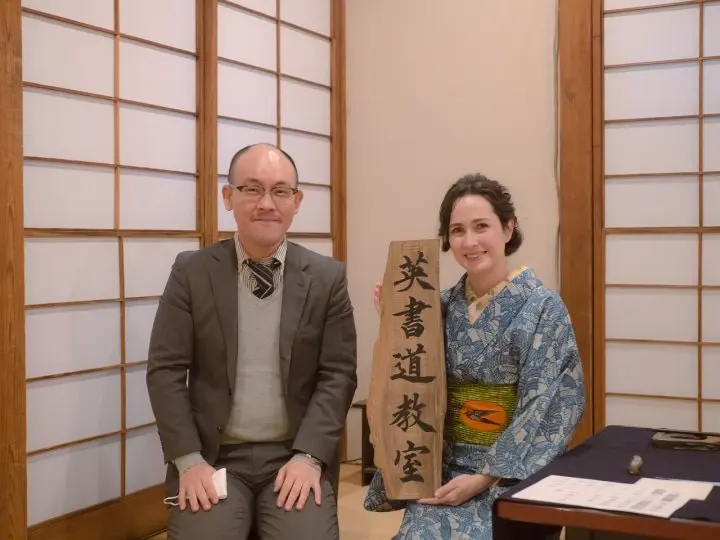
From shamisen, to shodo, delicious traditional food to beautiful traditional architecture, Ito Ryokan is like a microcosm of traditional Japanese culture.
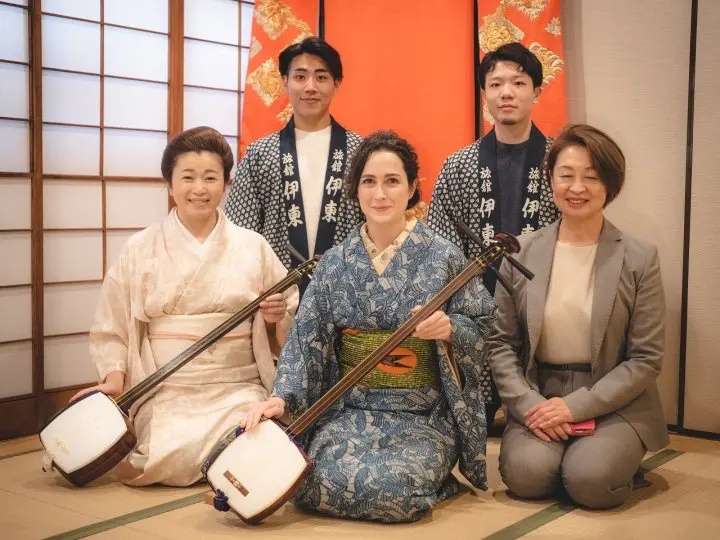
After spending the day here, I can tell that Chikako-san and Ito Ryokan’s staff will do anything and everything within their power to make the guests’ stay pleasant, comfortable, and fulfilling.
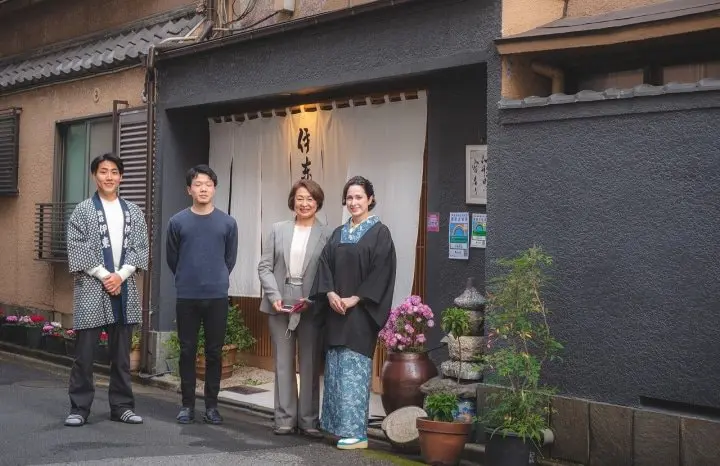
It’s apparent that Chikako-san really enjoys her job and interacting with all the guests that visit from around the world, and my day has been full of laughter and interesting stories of past guests that she has shared with me. Who knows, maybe the next story she will share will be one about you.
Hotels near Ito Ryokan
I am an actress and model living in Japan. Tokyo Ryokan Stories is my essay series about less-known but amazing ryokan and hotels in Tokyo.



